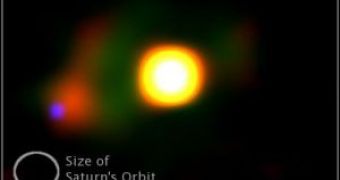Since long, astronomers have thought that the dusty disks where planets form are found around young stars in stellar nurseries, but recently, for the first time, a planet-forming disk has been discovered in the environment of a dying star.
Material from the dying star Mira A has been captured into a disk around Mira B, its companion.
This means there should be many similar undiscovered systems in the solar neighborhood, providing a myriad of new places to look for young planets orbiting stars.
Mira ("Miracle star") is located 350 light years away in the constellation of Cetus, and four centuries ago astronomers observed changes in its brightness: 1 month per year it is visible to the naked eye, while the rest of the 11 months it becomes 1,000 times fainter.
"When looking at one of the most celebrated and well-studied stars in the galaxy, I was amazed to find something new and unexpected!" said Michael Ireland of the California Institute of Technology.
"The discovery not only changes the way we think about a star that's important historically, but also how we'll look at similar stars in the future."
Mira is now a dying star, losing its dusty outer layers at a rate of one Earth-mass every seven years. All this material would be lost in outer space, but Mira (like 66 % of all stars) has a companion star, Mira B, that orbits around it, with a period of about 1,000 years. The gravitational field of Mira B catches nearly 1 % of the material lost from Mira A.
High-contrast techniques at the 10-meter Keck I telescope in Hawaii and the 8-meter Gemini South telescope in Chile revealed to the astronomers heat radiation originating not only from Mira B itself, but also from a location offset from Mira B.
"Observing Mira in the infrared is like staring straight down the barrel of one of the brightest searchlights in the galaxy. It came as a real revelation to see this faint mote of dust, harboring all the possibilities of new worlds in formation, against the hostile environment of the Red Giant," said Peter Tuthill from the University of Sydney.
"Our new imaging method at Keck is revealing new details that were thought to be impossible to detect due to the blurring by atmospheric turbulence. In this case -- the "detail" we discovered is potentially a whole new class of planetary system in formation!" said John Monnier from the University of Michigan.
The radiation from Mira A, 5,000 times brighter than the sun, heats the edge of the disk to about the Earth's temperature and causes it an infrared brightness.
The material was proven indeed to be the edge of a disk. Also, Mira B was discovered as an ordinary star like the sun, although about half as massive.
In about one million years, Mira A will become a white dwarf. When that happens, the disk-creating process will stop and the disk could form new planets. "The expected abundance of this kind of system means a new way to find planets that we know are young around stars like our sun, " Ireland says.
In this case, the death of a star does not mean the death of its planetary system. "An aging star is laying the foundation for a new generation of planets", says Ireland.

 14 DAY TRIAL //
14 DAY TRIAL //